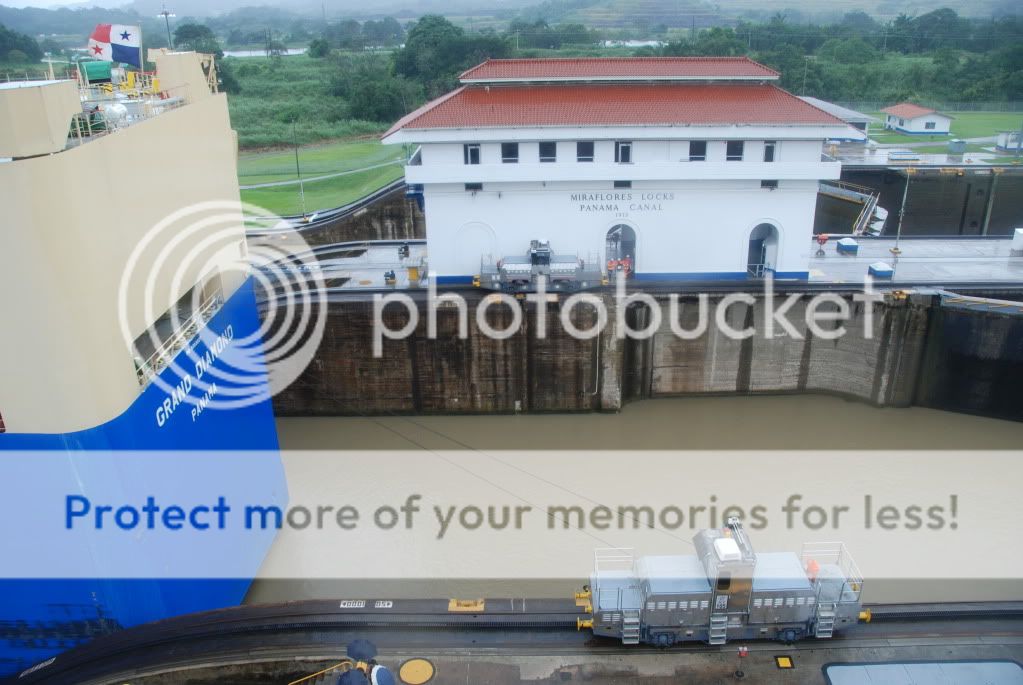Daryll writes:
Coming into Panama City, we were awe-struck with the towering “Bridge of the America’s” that spans the Panama Canal and leads into downtown Panama City. After checking out a few hostels and hotels, we finally found one that was affordable, yet decent with secure parking. Together with our friends Naomi and Alberto, we ran around the next morning trying to figure out how we get the bikes stamped out and learnt that it was an all day affair, so finally gave up and decided to take a cab to the Canal to spend the rest of the afternoon. As always, it rained on us the entire time we were out there.
 |
| Taking cover |
 |
| Miraflores Locks |
 |
| A yacht & a Panamax fast approaching |
Construction on the canal began in 1880 by the French, who had just successfully completed the Suez canal in Egypt. However, conditions in the dense, mountainous jungles of Panama proved far harsher than the flat, sandy desert of Egypt. Brutal working conditions, yellow fever and malaria claimed an estimated 22,000 lives before the project finally went bankrupt in 1889. In 1904, the project was taken over by the United States under Theodore Roosevelt, after orchestrating Panama's move for independence from Colombia the previous year. The discovery of mosquitoes as the carriers of yellow fever and malaria allowed for disease prevention, and work moved quickly under improved conditions, although it would claim another 5000 lives before completion. By 1914, the Canal (77km in length), a complex system of dams and locks, was open for transit, and ships that once were forced to travel to the southernmost tip of South America cut 12,500 kilometers (7,800 miles) from their voyages. It remained under full US administration until 1977, when a treaty was signed to hand over control of the Canal to Panama by 1999, with the US reserving the perpetual right to military intervention to protect its economic interests in the key shipping route. In 1999, all responsibility for the Canal was transferred to the government of Panama.
 |
| Yacht through |
The Canal has three sets of locks – Gatun, Pedro Miguel and Miraflores – each of which has two lanes. These locks serve as lifts, elevating vessels 85 feet above sea level from the lock’s chambers through a system of drains that extend under every lock chamber from the center and side walls. An average of 55 million gallons of fresh water is used, and takes about eight minutes to fill each chamber. After sailing through the Continental Divide, vessels are again lowered to sea level on the opposite side of the Isthmus of Panama.
 |
| Grand Diamond (a Panamax) |
A proposal to expand the Canal to accommodate larger shipping vessels was put to a referendum in September 2006, and approved by an 80% majority. The expansion, set to be completed in 2014, will double the waterway's capacity, with a third set of locks added to loosen congestion in the busy canal and make room for the latest generation of colossal container ships. .
 |
| On to the next chamber |
This was definitely a highlight of being in Panama thus far. A feat of engineering that has stood the test of time and the concept seems so simple. Using hydraulics, open and close a series of gates that fills and empties a series of chambers that either lifts or lowers the largest cargo vessels in the world. We visited the museum prior to seeing the two cargo ships come through the canal, hence all the history. The silver locomotives that run alongside the vessel acts as a brake and keeps the vessel in the center of the canal and the vessel is under it's own power while going through.
New photos added to the Panama photo album.










Greg writes... very cool to be at the canal I am sure. A new continent awaits you guys so enjoy and ride safe. Greg and Jill
ReplyDeleteYup, we leave tomorrow to load our bikes onto the sail boat and set sail on Dec 10th, so will be out of contact for a few days.
ReplyDeleteDaryll
Great pictures. Have fun playing in the sun, sand and surf.
ReplyDeleteRide Safe!
daryl